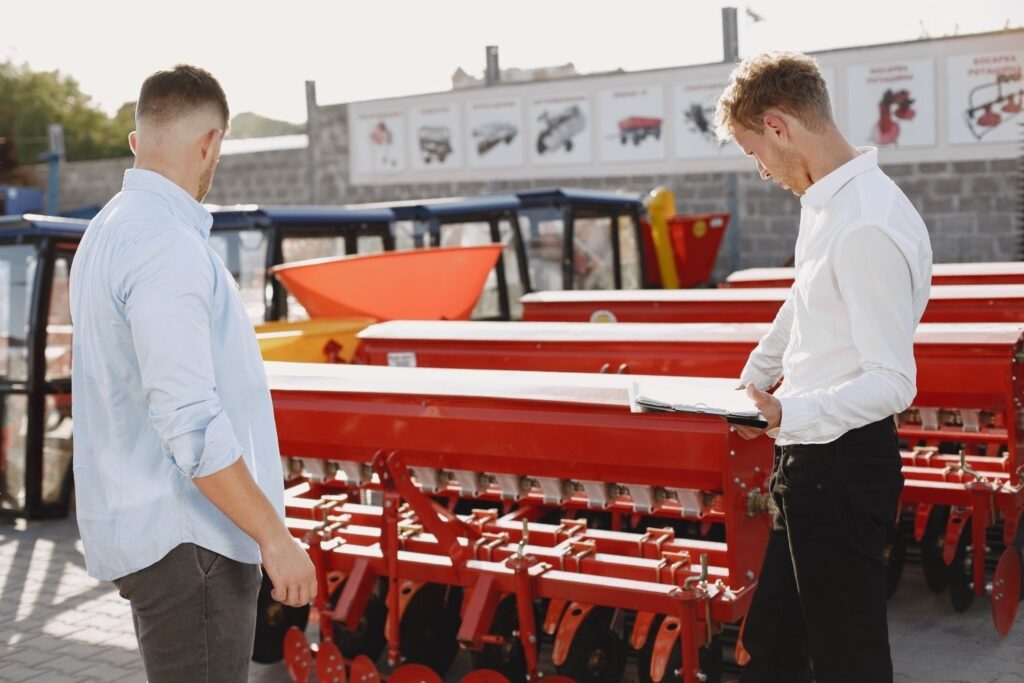You need a new tractor, planter, and tillage equipment this season. Should you finance them separately or bundle everything into one comprehensive farm machinery finance package? This decision affects your interest rates, monthly payments, approval odds, and long-term financial flexibility more than most farmers realise.
Equipment bundling—combining multiple purchases into a single loan—offers both compelling advantages and potential drawbacks. Understanding how bundling impacts your agriculture equipment financing helps you structure deals that maximise savings while maintaining operational flexibility. Let’s break down what bundling really means for your farm’s bottom line.
Understanding Equipment Bundling in Agricultural Finance
Equipment bundling combines two or more machinery purchases into a single financing agreement with one lender, one approval process, and one set of terms. Instead of securing separate loans for your $85,000 tractor, $45,000 planter, and $28,000 disc harrow, you finance all three together for $158,000 total.
This differs from simply having multiple loans with the same lender. Bundled financing treats the package as one transaction with unified terms, closing costs, and payment schedules. It’s the financial equivalent of buying a complete equipment lineup rather than individual pieces.
Ag equipment financing bundling comes in several forms. Complete operation packages bundle all equipment needed for specific farming operations—everything for a row crop setup or a complete harvest package. Seasonal bundles group equipment used together during specific times—planting equipment in spring and harvest equipment in fall. Upgrade bundles combine new purchases with trade-ins across multiple equipment categories.
Lenders often encourage bundling because it reduces their administrative costs and allows them to spread risk across multiple assets. For borrowers, bundling can unlock volume discounts, simplified paperwork, and sometimes better overall terms. However, it also creates interdependencies that limit flexibility.
The key is understanding whether bundling serves your operation’s specific needs or simply makes the lender’s process easier at your expense.
Financial Advantages of Bundling Equipment Purchases
The most immediate benefit of bundled agriculture equipment financing is reduced closing costs. Instead of paying origination fees, processing charges, and documentation fees on three separate loans, you pay them once on the combined amount. This can save $750 to $2,500 depending on lender fee structures.
Interest rates may improve with bundling. Larger loan amounts give you more negotiating leverage, and lenders sometimes offer rate discounts on packages exceeding certain thresholds—often $100,000 or $150,000. A 0.25% to 0.5% rate reduction across a $150,000 loan saves roughly $2,000 to $4,000 over a 5-year term.
Administrative simplicity shouldn’t be underestimated. One application, one approval, one closing, and one monthly payment reduce the paperwork burden substantially. You’re not juggling multiple due dates, payment accounts, or lender relationships. For farmers already managing complex operations, this streamlining has real value.
Bundling can improve approval odds for borderline applicants. If your debt-to-income ratio is tight, one bundled loan may pass underwriting where multiple separate applications might trigger denials. Lenders evaluate the complete package differently than they would individual requests submitted separately.
Cash flow advantages emerge through unified payment schedules. Coordinate all equipment payments to align with harvest revenue or seasonal income patterns. Instead of scattered payments throughout the year, structure one comprehensive payment plan that matches your farm’s cash flow reality.
Volume discounts on equipment purchases often accompany financing bundles. Dealers know bundled deals close more reliably, so they’re frequently willing to reduce per-unit prices by 3% to 7% when you’re purchasing multiple pieces simultaneously. Combined with financing advantages, total savings can reach 10% or more compared to separate purchases.
Tax Benefits and Depreciation Strategies
Bundled equipment financing offers strategic tax planning advantages. Section 179 deductions allow immediate expensing of equipment purchases up to annual limits ($1,160,000 for 2025, subject to phase-outs). Bundling lets you strategically time purchases to maximise current-year deductions or spread them across tax years for optimal benefit.
Bonus depreciation—currently 60% in 2025 before phasing out—applies to bundled purchases just as it would to separate transactions. However, bundling gives you flexibility in how you categorise and depreciate different equipment types for maximum tax efficiency.
Consider this example: financing a $200,000 equipment bundle allows you to take the entire $200,000 Section 179 deduction in one year if it benefits your tax situation. Alternatively, you might elect to take $100,000 immediately and carry forward $100,000 in depreciation for future years. Separate loans make this coordination more complex.
Consult with your tax advisor about timing equipment bundles for maximum benefit. End-of-year purchases capture full-year depreciation even if acquired in December, but this only makes sense if your tax situation supports it. Bundling with strategic timing creates flexibility separate purchases can’t match.
Potential Drawbacks and Risks of Bundled Financing
If one component of your bundle falls through—say the dealer can’t deliver the planter by closing—the entire financing package may collapse. You’re back to square one on all equipment rather than just the delayed item. This interdependency creates risk during planting or harvest seasons when timing is critical.
Longer average useful life across bundled equipment can create problems. A tractor might serve you for 10 years, but precision planting technology might need upgrading in 5 years. Bundling them on a 7-year loan means you Despite advantages, bundled farm machinery finance carries risks that demand careful evaluation. The most significant is reduced flexibility in managing individual equipment pieces. If you want to pay off just the planter early or trade in only the tractor, unbundling specific items from a package deal proves difficult or impossible.
Most bundled financing treats all equipment as collectively securing the loan. You can’t sell, trade, or pay off individual items without lender permission and potential penalties. This lack of flexibility becomes problematic if one piece of equipment fails, requires upgrading, or no longer fits your operation.
Interest rate uniformity can work against you. In bundled packages, all equipment carries the same interest rate regardless of individual value, depreciation, or risk profile. New equipment that might qualify for 6.5% financing gets bundled with used equipment that might otherwise carry 7.5% rates—the package rate might land at 7.0%, costing you more on the new equipment.
u’re paying for obsolete equipment in later years or refinancing prematurely to upgrade.
Cross-collateralization clauses in bundled loans mean defaulting on any portion puts all equipment at risk. If you struggle financially and can’t make the unified payment, the lender can repossess everything—not just the piece causing financial strain. Separate loans provide more targeted risk management.
How Bundling Affects Loan Terms and Conditions
Loan term length on bundled ag equipment financing typically reflects the average useful life of included equipment, which may not align perfectly with any individual item. A bundle including a $120,000 tractor (10-year life) and $40,000 in tillage equipment (5-7 year life) might get a 7-year term—too long for the tillage equipment, too short for the tractor.
This mismatch affects equity building and resale strategy. You might be upside down on tillage equipment (owing more than it’s worth) in later years while building substantial equity in the tractor. Separate loans let you match terms precisely to each equipment type’s depreciation curve.
Down payment requirements often decrease as a percentage with bundling. While you might need 20% down on a $85,000 tractor ($17,000), a $158,000 bundle might only require 15% ($23,700). You’re putting down more total dollars but less proportionally, preserving working capital.
However, some lenders calculate down payments on the highest-risk item in the bundle. If you’re including used equipment with new purchases, the lender might require 25% down on the entire package rather than blended rates. Always clarify how down payments are calculated on bundled deals.
Interest rate structures can include volume-based tiers. Once you exceed certain thresholds—$100,000, $150,000, $250,000—rates may drop by 0.25% per tier. A $95,000 purchase might carry 7.5%, while a $155,000 bundle drops to 7.0%. Understanding these tiers helps you decide whether adding items to reach the next tier makes financial sense.
Prepayment penalties on bundled loans can be more restrictive. Lenders invest more administrative effort in large packages and may impose stiffer penalties for early payoff. If you anticipate paying down debt aggressively during profitable years, negotiate prepayment terms upfront or consider separate loans for flexibility.
Strategic Approaches to Equipment Bundling
Not every situation demands all-or-nothing choices. Smart farmers use hybrid bundling strategies that balance efficiency with flexibility.
Consider bundling complementary equipment that you’ll use together for similar durations. A tractor and front-end loader make sense as a bundle—you’ll keep both for the tractor’s useful life. Bundling a tractor with a planter you might upgrade in 3 years creates mismatched timelines.
Separate high-value, long-life equipment from smaller, shorter-life items. Finance your $150,000 combine separately with a 7-year term while bundling smaller items—grain cart, grain bin augers, utility trailer—on a separate 3-5 year package. This approach maintains flexibility on major equipment while capturing bundling benefits on minor purchases.
Use bundling strategically during strong commodity price years. When profitability is high and you’re making multiple equipment upgrades, bundle purchases to maximize tax deductions and lock in competitive rates. During uncertain years, keep loans separate for maximum flexibility in managing cash flow and equipment decisions.
Negotiate partial unbundling provisions in your loan agreement. Some lenders allow you to pay off or trade individual items within a bundle if you maintain minimum loan balances or substitute comparable collateral. Including these provisions at loan origination provides flexibility without sacrificing bundling advantages.
Consider timing bundles around manufacturer incentives. Equipment makers often offer promotional financing (0% for 24 months, reduced rates, etc.) on bundled purchases during slow sales periods—typically late fall and winter. These programs can dramatically reduce financing costs if timed properly.
Comparing Bundled vs. Separate Financing Scenarios
Let’s examine real numbers to see how bundling impacts total costs. Suppose you need:
- Tractor: $85,000
- Planter: $45,000
- Tillage equipment: $28,000
- Total: $158,000
Separate Financing Scenario:
- Three origination fees @ 1.5%: $2,370
- Interest rates: Tractor 7.0%, Planter 7.25%, Tillage 7.5%
- Five-year terms on all three
- Total interest paid: ~$31,800
- Total cost: $192,170
Bundled Financing Scenario:
- One origination fee @ 1.5%: $2,370 (saving $1,580)
- Negotiated interest rate: 6.75% (0.25% discount for package)
- Five-year term
- Total interest paid: ~$28,900
- Total cost: $189,270
The bundled approach saves approximately $2,900 over five years—combining reduced fees and lower interest rates. However, this assumes you keep all equipment for the full term and don’t need flexibility to trade or upgrade individual items.
If you trade the planter after 3 years in the bundled scenario, you’ll need to pay off that portion (roughly $20,000 remaining) plus potential unbundling fees ($500-$1,500). The separate financing scenario allows you to simply pay off or trade the planter independently without affecting other equipment.
Conclusion
Equipment bundling in farm machinery finance offers genuine advantages—reduced fees, potentially lower rates, simplified administration, and better tax planning flexibility. For farmers making simultaneous equipment purchases with similar useful lifespans, bundling can save $3,000 to $8,000 or more compared to separate loans.
However, bundling sacrifices flexibility. You’re locked into unified terms across all equipment, facing challenges if you want to trade, upgrade, or pay off individual items. The best approach depends on your specific equipment needs, anticipated holding periods, and how much you value financial flexibility versus cost savings.
Smart farmers evaluate bundling on a case-by-case basis rather than always bundling or always separating. Consider complementary equipment, matching useful lifespans, and negotiating partial unbundling provisions that preserve flexibility while capturing efficiency benefits.
Moorefield-area farmers benefit from discussing bundling strategies with agricultural lenders who understand equipment values and can structure packages that balance savings with operational flexibility.
FAQ Section
Q-1: Can I add equipment to an existing bundled loan later?
Typically no. Most lenders require refinancing the existing bundle and originating a new loan to add equipment. Some offer “add-on” provisions in original loan agreements, but these are uncommon and usually carry fees.
Q-2: What happens if I want to trade one item from a bundled package?
You’ll need lender approval to release that item from the collateral agreement. Most lenders require you to either: (1) pay off that portion of the loan, (2) substitute comparable collateral, or (3) refinance the remaining balance. Expect fees for unbundling.
Q-3: Are interest rates always better on bundled equipment financing?
Not always. Rates depend on total loan amount, your credit profile, and whether bundling crosses volume-discount thresholds. Sometimes bundling averages rates in ways that actually cost more on new equipment while saving on used items.
Q-4: Should I bundle new and used equipment together?
Generally avoid this. New and used equipment have different depreciation rates, useful lifespans, and risk profiles. Bundling them may result in suboptimal terms for one or both categories. Consider separate financing for new versus used purchases.
Q-5: How does bundling affect my ability to claim Section 179 deductions?
Bundling doesn’t limit Section 179 eligibility, but it gives you flexibility in timing purchases and deductions across tax years. Consult your tax advisor about optimal timing for bundled equipment purchases to maximize tax benefits.



